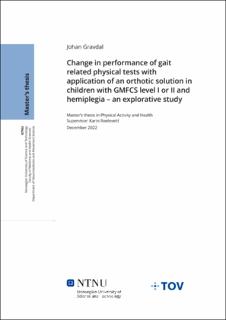| dc.contributor.advisor | Roeleveld, Karin | |
| dc.contributor.author | Gravdal, Johan | |
| dc.date.accessioned | 2023-02-08T18:19:36Z | |
| dc.date.available | 2023-02-08T18:19:36Z | |
| dc.date.issued | 2022 | |
| dc.identifier | no.ntnu:inspera:105945279:46743481 | |
| dc.identifier.uri | https://hdl.handle.net/11250/3049452 | |
| dc.description.abstract | Bakgrunn: Ankel - fotortoser (AFO) og “functional electrical stimulation” (FES) er ortoser som ofte blir tilpas-set barn med spastisk hemiplegi for å forbedre gangen. Barns daglige aktiviteter består for øvrig av flere bevegelser enn kun gange på flatt underlag, og få studier har sett på effekten av ortosen på prestasjon i slike aktiviteter, som er viktige for deltakelse med normalt utviklende (TD) jevnaldrende.
Mål: Hovedmålet er å se hvordan bruken av ortose påvirker prestasjon i forskjellige fysiske tester som in-kluderer bevegelser typisk representert i barns daglige aktiviteter. Vi ønsker også å undersøke om bruken av ortose påvirker ubehag under utførelse av de fysiske testene.
Metode: 16 deltakere, alder 6 – 13 år, som bruker ortose på daglig basis (9 AFO, 7 FES), ble rekruttert. De var diagnostisert med spastisk hemiplegi og hadde nivå I eller II på “Gross Motor Function Classification Sys-tem“ (GMFCS). Deltakerne ble instruert til å utføre åtte forskjellige fysiske tester, inkludert gange i selvvalgt hastighet og maks ganghastighet, løping, løping med raske vendinger, hopping, forflytning fra gulv og fra stol, og gange i trapp. Hver deltaker utførte testene to ganger, én gang med ortosen og én gang uten, i ran-domisert rekkefølge. Ubehag under gjennomføring av testene ble rapportert i form av “Face Pain Scale” (FPS). For å undersøke effekten av ortoseløsningen, gjennomførte vi en paret t-test på prestasjon med og uten ortose for AFO- og FES-brukere som en kombinert gruppe og også som separerte grupper.
Resultater: FES-brukere hadde en statistisk signifikant redusert prestasjon i “1 minute walk test” (p=0.013) med bruk av FES. Det var også en signifikant reduksjon i prestasjon for kombinert gruppe i “10x5m shuttle run” (0=0.029) med bruk av ortose. En statistisk trend i redusert prestasjon ble vist i “timed up and go” (0.069) og “broad jump” (p=0.06) for kombinert gruppe med bruk av ortose, og i “10x5m shutte run” (p=0.054) for AFO-brukere separert.
Konklusjon: Fra våre resultater er det ingen indikasjon på at AFO eller FES forbedrer prestasjon i gangrela-terte fysiske tester for barn med GMFCS nivå I eller II. Det ser ut som det er en liten reduksjon i prestasjon i noen tester, men sannsynligvis av liten klinisk betydning. Dette ekskluderer ikke muligheten for individuelle forbedringer eller forbedringer i andre ICF-domener med bruk av ortose, for eksempel for å redusere energi-forbruk. | |
| dc.description.abstract | Background: Ankle foot orthosis (AFO) and functional electrical stimulation (FES) are commonly used or-thoses for improving gait in children with spastic hemiplegia. However, children’s daily activities include movements beyond gait on even ground, and few studies have examined the effect of the orthosis on the performance of such activities which are important for participation with typical developing (TD) peers.
Aim: The main aim is to see how the use of orthosis affects performance of different physical tests including movements typically represented in children’s daily activities. We would also like to investigate if the use of orthosis affects discomfort while performing the physical tests.
Method: 16 participants, age 6 – 13 years, using an orthosis on regular basis (9 AFO, 7 FES) were recruited. They were diagnosed with spastic hemiplegia and had level I or II on the Gross Motor Function Classification System (GMFCS). Participants were instructed to perform eight different physical tests, including walking in self-selected speed and maximum speed, running, running with sudden change of direction, jumping, transi-tion from floor and chair, and walking in stairs. Each participant conducted the tests twice, once with their orthosis and once without, in randomized order. Discomfort while performing the tests was reported in form of “Face Pain Scale” (FPS). To investigate the effect of the orthotic solutions, we conducted a paired t-test on the performance with and without the orthoses for AFO and FES users as a combined group and also separate groups.
Results: FES users decreased performance in “1 minute walk test” when wearing FES (p=0.013). There was also a significant decrease in performance for the combined groups in “10x5 meter shuttle run” with the use of the orthosis (p=0.029). A statistical trend of decreased performance was shown in “timed up and go” (p=0.069), and “broad jump” (p=0.06) for the combined groups with the use of the orthosis, and in “10x5 meter shuttle run” for AFO users separately (p=0.054).
Conclusion: From our results, there is no indication that AFO or FES improves performance of gait related physical tests in children with GMFCS level I or II. There seems to be a small decrease in performance in some tests, but likely of minor clinical importance. This does not exclude the possibility for individual improvements nor improvements in other ICF domains with the use of orthosis, for example to reduce energy expenditure. | |
| dc.language | eng | |
| dc.publisher | NTNU | |
| dc.title | Change in performance of gait related physical tests with application of an orthotic solution in children with GMFCS level I or II and hemiplegia – an explorative study | |
| dc.type | Master thesis | |
